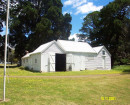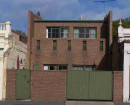Seymour Avenue of Honour
Seymour, MITCHELL SHIRE
-
Add to tour
You must log in to do that.
-
Share
-
Shortlist place
You must log in to do that.
- Download report
Statement of Significance
This record has minimal details. Please look to the right-hand-side bar for any further details about this record.
-
-
Seymour Avenue of Honour - Physical Description 1
Avenue: 115 trees
Seymour Avenue of Honour - Historical Australian Themes
Remembering the fallen
Seymour Avenue of Honour - Usage/Former Usage
Commemoration
Veterans Description for Public
Seymour Avenue of Honour - Veterans Description for Public
The Seymour Avenue of Honour was planted with 115 trees along the old Trawool Road. The Avenue was begun in 1917 and was planted by school children in memory of those locals who served in the First World War. The Avenue is now known as Anzac Avenue and the trees have been replaced by a monument on the median strip.
In Australia, commemorative trees have been planted in public spaces since the late nineteenth century. Arbor Days were held regularly in most Victorian State Schools during the late 1800s and early 1900s, and numerous trees were planted in parks in Melbourne and throughout Victoria to mark the visits of important and famous people.
This tradition of commemorative planting was continued in 1901 when at the end of the Boer War trees were often planted for each soldier of the district who was killed in South Africa. These plantings, however, rarely consisted of more than two or three trees in each town.
During and after the First World War avenues of honour consisting of trees lining significant streets became a popular form of commemoration. They represented a new egalitarian approach to the commemoration of soldiers where rank was not a consideration: each tree symbolises a person.
Avenues of honour are a uniquely Australian phenomenon. Australians, and in particular Victorians, embraced the idea of planting them more enthusiastically than any other country in the world. Dating from May 1916, the Eurack Avenue of Honour is the earliest known avenue of honour to be planted in Victoria.
By the time of the Second World War avenues of honour had declined in popularity as a means of commemoration. Today it is estimated that over 300 avenues of honour have been planted in Victoria to commemorate service personnel since 1901.
-
-
-
-
-
SEYMOUR RAILWAY STATION
 Victorian Heritage Register H1591
Victorian Heritage Register H1591 -
SEYMOUR ROTARY PARK PILINGS
 Victorian Heritage Inventory
Victorian Heritage Inventory -
Former Court House
 National Trust
National Trust
-
1 Brockenshire Street
 Yarra City
Yarra City -
1 Bundara Street
 Yarra City
Yarra City -
1 Forster Street
 Hobsons Bay City
Hobsons Bay City
-
-











